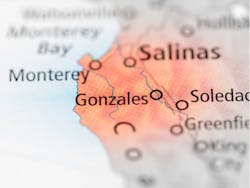Concentric Power has struck a deal to build a 35-MW microgrid project in Gonzales, California that will operate under an unusual wholesale power agreement that involves a municipal utility, a local electric authority and retail customers.
Unveiled yesterday, the $70 million microgrid is an economic development play to help attract businesses to the Gonzales Agricultural Industrial Business Park in Salinas Valley. Access to reliable power is one of the factors delaying full buildout of the park, which is now at about one-third capacity, according to Brian Curtis, founder and CEO of Concentric Power.
Concentric announced the project after signing a 30-year energy services agreement to deliver wholesale electric power via the microgrid to customers in and around the industiral park, which houses some of the country’s largest fresh vegetable and wine producers. Concentric will develop, design, build, operate and maintain the microgrid assets.
Expected to be completed in little over a year, the microgrid will use solar and energy storage with natural gas in a supporting role; specifically, 14.5 MW-AC of solar, 10 MW/27.5 MWh of battery energy storage, 10 MW of flexible thermal generation and a Concentric microgrid controller.
Concentric also will build distribution infrastructure and a substation that ties into a high voltage line. The privately owned substation will allow the microgrid to sell energy and capacity to the California grid.
How contracts work
While campus style microgrids are common, this one is unusual contractually and could serve as a model for other municipalities or campuses looking at microgrids, Curtis said.
Concentric signed the wholesale power agreement with the Gonzales Electric Authority, formed in 2018 by the city to provide power to the industrial park. The city also created a municipal utility. So Concentric’s project company will sell power to the authority, which will then run that power through the municipal utility. The municipal utility will distribute it at retail rates to customers in the park.
“I’m optimistic that it will open up an avenue for a lot of private capital to flow into projects like this for economic development reasons,” Curtis said.
Lower energy costs
The microgrid is expected to provide cost savings to its customers, by selling power to the authority at a wholesale rate of 11.75/kWh. The municipal utility has yet to roll out the retail rate. But it’s expected to undercut what agricultural processors in the park now pay, an average of $0.20161/kWh under a PG&E tariff, which has climbed significantly in recent years.
Courtesy of Concentric Power
The parties also are structuring feed-in tariffs to accommodate generation that already exists in and around the industrial park, including wind turbines and solar. The industrial park is home to a small microgrid, powered by a wind, solar and a 2-MW cogeneration system installed by Concentric at a Taylor Farms processing facility in 2016.
Leverages dispatchable assets
Like many advanced microgrids, the new project will leverage dispatchable assets to tamp down its energy costs, finding opportunities for load management and sale of services to the grid.
“We’ve developed a platform to optimize a microgrid in general, but also focus on dispatchable assets, whether that’s engines or batteries or other forms of generation, to make the microgrid really sing,” Curtis said in an interview with Microgrid Knowledge.
The city has experienced utility power shutoffs related to California’s wildfires, a hardship that has created a microgrid development boom in the state over the last year. But the Gonzales microgrid is not a product of the trend. Instead, its origins go back three years when the city balked at the length of time it would take for Pacific Gas & Electric to make substation improvements to provide power for the industrial park.
In its Climate Action Plan, the city says that it was told by PG&E that it could take up to three years to build necessary utility infrastructure at a cost of up to $25.4 million to provide up to 18 MW to the business park.
So the city intead opted to build the microgrid. Still, Curtis said he sees the decision as a win for PG&E.
“I think this is an important piece of the puzzle,” he said. “It’s actually going to save them time and money in the form of deferred substation work and allow them to focus on some of their big priorities as PG&E comes out of bankruptcy and gets restructured.”
Reliability and sustainability play for Gonzales
While economic development was the main driver for the microgrid, it also will provide power reliability. The microgrid will have the ability to fully island from the main grid, allowing the industrial park to self-generate. The project also is a sustainability play, in that it will help Gonzales meet its Climate Action Plan.
“The companies who do business here need to know that they will have the power they need, when they need it, from a variety of green and low-carbon sources,” said Maria Orozco, mayor of the City of Gonzales. “This is exactly the kind of project that benefits everyone involved: dependable, independent power that helps us reach our sustainability goals. This agreement will help deliver that.”
Schematic of Gonzales-Concentric microgrid. Courtesy of Concentric
Concentric providing financing
Last year, the city issued a request for information for the microgrid and selected Concentric as a result. For about the last 10 months, the company has been working with the city on the project under a memorandum of understanding. Others working on the project include the city’s consultants ZeroCity and OurEnergy.
Concentric will act as primary project financier, with supplemental funding from the electrical authority and municipal utility, which will be applied towards the municipal utilities eventual ownership of the distribution infrastructure.
The company also plans to build a network operations center, field office and shop in the industrial park.
Because the industrial park is served by a municipal utility, the microgrid does not face ‘over-the-fence’ restrictions — prohibitions to wheeling power over utility rights of way — common in California and other states. So it will be able to sell power outside of the industrial park’s footprint.
Concentric expects to break ground on the microgrid in mid-2021 and have it ready for service in 2022.
Learn more about the Gonzales microgrid in a presentation by Concentric Power at Microgrid 2020 Global. Registration is free, but participation is limited, so don’t miss out. Register soon!







